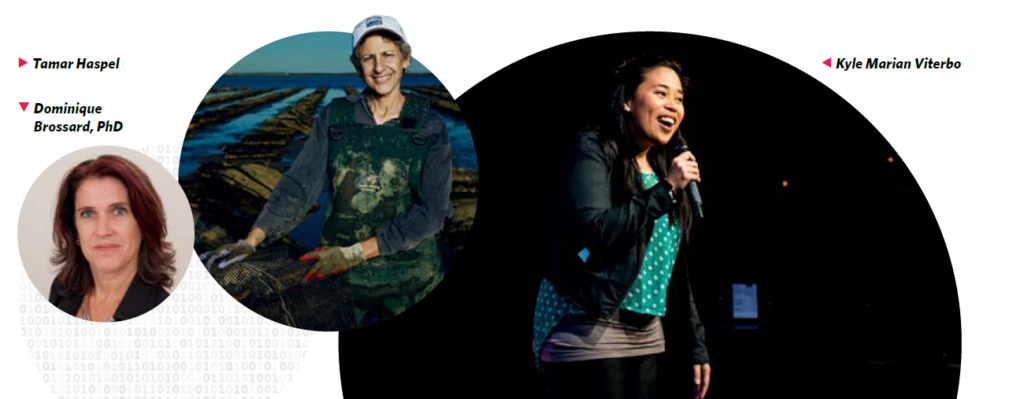Science and Social Media: #facepalm or #hearteyes?
Beneath all the negative noise, science can flourish on social media, but users must be diligent, measured, and ethical with how they use this powerful platform.
Published June 1, 2019
By Kari Fischer, PhD
Academy Contributor

Somewhere in between those halcyon days of Facebook as a friendly college social media network and the acrimonious 2016 elections, meme-filled newsfeeds took over, and social media sites like Facebook, Twitter, YouTube and Pinterest transformed into new express lanes for the spread of misinformation. This development feels especially glaring in science.
As the use of social media expanded it also became a major source for news and information. A 2018 Pew Research Center study found that 68 percent of American adults get news through social media sites. That change held not only for politically-themed content, but for science too. Another 2018 Pew study found that most users report seeing science-related posts, and 33 percent view it as a source for science news. Millions follow science-related pages on social media with the most popular pages including National Geographic, IFL Science, NASA, and ScienceAlert.
As news sources become increasingly fractured, it is difficult to dig through the mountains of contradictory articles, especially when we are asked to evaluate highly technical subjects that might be communicated poorly — sometimes intentionally so. The aforementioned list of influential “science-related” pages also includes those whose basis in empirical data is more loosely defined, like that of Dr. Mehmet Oz. In 2014 he was called before Congress for promoting sham supplements, and recently tweeted about the link between astrology and health. His page has over 5.5 million followers.
Flawed information has a way of spreading quickly. Of the 100 most shared health-related articles in 2018, over half of the articles contained misleading or exaggerated statements, or even outright falsehoods. Some of those articles even came from reputable news sources.
The Pervasiveness of False Information
The pervasiveness of false information on social media may translate to an effect on public health. When measles outbreaks increased 30 percent worldwide, vaccine misinformation on the internet took center stage. A recent study in the United Kingdom from the Royal Society for Public Health showthat 50 percent of parents with young children were exposed to negative messages about vaccines on social media.
This did not happen entirely organically. Russian trolls engaged not only in spreading political falsehoods, but they heightened the debate around vaccines too. A study analyzing tweets from 2014 to 2017 revealed that known Russian accounts tweeted about vaccines at higher rates than average users. The content of their tweets presented both pro- and anti-vaccine messages, a known tactic that amplifies a sense of “debate” and therefore propagates a sense of uncertainty.
Why are these misleading posts so attractive? Dominique Brossard, professor and chair in the Department of Life Sciences Communication at the University of Wisconsin-Madison, pulls no punches in her assessment, “They’re using all the strategies that unfortunately the scientific community has not been using.” She emphasizes that they exploit the most fundamental driver of whether or not information is accepted: trust. “What are the main things that build trust? Concern, care and honesty.” Or at least the perception of honesty.
The strength of these tactics can be especially heightened when they are insulated from outside influence. Many organizations against vaccines structure their Facebook groups so that they are closed or private, allowing for misinformation to be stated entirely unchecked and out of the public eye.
The Effect on Public Opinion
But, as all good scientists know, correlation does not equal causation. The pervasiveness of false information does not mean that there is a straight line of causality to an effect on public opinion. “It’s hard to quantify the effects of misinformation,” Brossard cautions. That same 2018 Pew study revealing 68 percent of American adults getting news on social media also stated that 57 percent expect the news they see to largely be inaccurate.
The public may also be changing how they’re interacting with social media. After the 2016 elections and the Cambridge Analytica scandal, some users needed a pause. On Facebook, 54 percent of adults modified their use in 2018: adjusting their privacy settings, deleting the app from their cellphone, or even taking extended breaks.

Social media companies are also modifying their approach. Pinterest blocked users from searching for vaccine-related terms. YouTube removed advertisements from anti-vaccine themed videos, and recently pledged to curb the spread of misinformation by modifying its recommendation algorithms — hopefully preventing users from following conspiracy-laden video rabbit holes.
And in spite of all the misleading content, which prompts all scientists to reply #headdesk or #facepalm — that’s social media speak for frustration or exasperation — there are many exciting online communities that may provide some redemption for these platforms.
Recognizing the opportunity to cater to the sci-curious, experts in science outreach jumped online as a way to spread a passion for science. YouTube accounts like AsapSCIENCE and Physics Girl have millions of subscribers, and take the time to break down complex subjects for their audiences.
Scientists and Instagram
On Instagram, science.sam is the account of Samantha Yammine, who uses the platform as a new line of communication with the public. While earning her PhD, she shares her daily life as a researcher through photos and videos both in and outside of the lab, with a humanizing effect. She also contributes to a research study nicknamed #ScientistsWhoSelfie, which is systematically exploring the effects of scientists’ Instagram posts to influence public perception of scientists.
Social media also provides a megaphone to amplify diverse voices in science, and remove hierarchies that exist offline. The accounts belonging to #VanguardSTEM link to live, monthly interviews with both “emerging and established women of color in STEM,” where they cover research, career advice and social commentary.
Kyle Marian Viterbo, social media manager at Guerilla Science and producer of The Symposium: Academic Stand-Up, cites her experience in biological anthropology groups on Facebook as some of the earliest examples of social forums for scientific discussion, where status and titles were stripped away. “We talked about papers and coverage of papers in depth, in a way that only an academic community can. It’s been an amazing experience to see that community grow, and add new scientists who have equal conversation power with folks who are emeritus professors.”
Scientists and Twitter
A 2017 study estimated that over 45,000 scientists use Twitter. From volcanologists, to climate scientists, to evolutionary biologists, they’re all online in a professional capacity. There, they share new papers, announce job openings in their labs, comment on published research and network with other scientists both in and outside of their field.
For science professionals who feel emboldened to get online, but don’t know how, Viterbo advises easing your way in, “My number one advice is to just lurk. You’re silent, you’re observing, it’s almost like an ethnography situation…you don’t have to be active. A lot of it is also getting to know what you want out of that experience, and you don’t really know that until you see other people doing it well, and it resonates.”
Once your field observations are complete, Viterbo says it’s time to experiment with a few posts, “You just have to play in this space, and allow yourself to make a few mistakes.” She reminds scientists that we have the instincts for learning how to do well, but we can also get out of our own way, “Apply the scientific method to communication and social media, but also be more forgiving. We’re not necessarily the most forgiving of ourselves in science, but do it for fun!”
Communication Works Both Ways
If you plan on venturing into social media with an agenda in mind, perhaps take a cue from Tamar Haspel, a science journalist who writes the award-winning Washington Post column Unearthed. She spends much of her time researching controversial topics like pesticides, GMOs and diet recommendations, and cautions scientists to remember that “communication works both ways.”
Haspel makes a point to read thoughtful discussions from all sides, even on Twitter, “I have smart people with wildly different views in my feed, and I pay attention when they post something, because of course when we see something that we don’t want to believe we have a tendency to just scroll down. I try to stop, click through, and listen.” Her own posts are comprehensive explainers on the complex science of agriculture, and she also readily self-corrects and engages politely on divisive topics.
The result has positioned her as a trustworthy source for information. Haspel’s number one piece of advice for scientists who want to achieve the same? “We need to think less about being persuasive, and think more about being persuadable.
Also read: Deepfakes and Democracy in the Digital Age
